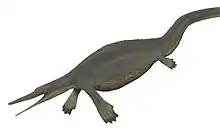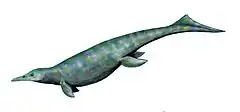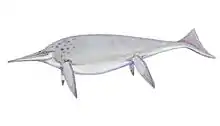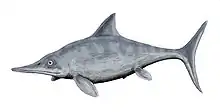Maiaspondylus
Maiaspondylus is an extinct genus of platypterygiine ophthalmosaurid ichthyosaurs known from Northwest Territories of Canada, the Cambridge Greensand of England and the Voronezh Region of Russia.[1][2]
| Maiaspondylus | |
|---|---|
| Scientific classification | |
| Kingdom: | Animalia |
| Phylum: | Chordata |
| Class: | Reptilia |
| Order: | †Ichthyosauria |
| Family: | †Ophthalmosauridae |
| Subfamily: | †Platypterygiinae |
| Genus: | †Maiaspondylus Maxwell & Caldwell, 2006 |
| Species: | †M. lindoei |
| Binomial name | |
| †Maiaspondylus lindoei Maxwell & Caldwell, 2006 | |
| Other species | |
| |
| Synonyms | |
| |
Description
Maiaspondylus is known from the holotype UALVP 45635, a disarticulated but nearly complete skeleton preserved in three dimensions and from the referred materials UALVP 45639, two articulated, partially preserved embryos and eight articulated vertebrae of an adult, UALVP 45640, 14 articulated vertebrae of a juvenile, UALVP 45640, 12 articulated vertebrae, UALVP 45642, a partial snout and left dentaries with teeth and UALVP 45643, a fragmentary snout. All specimens were collected at Hay River from the Loon River Formation, dating to the early Albian stage of the Early Cretaceous, about 110 million years ago.[1]
All Maiaspondylus specimens were originally referred to Platypterygius. However, all recent cladistic analyses found that Maiaspondylus is a valid genus of ophthalmosaurid.[3][4] Patrick S. Druckenmiller and Erin E. Maxwell (2010) found it to be most closely related to "Platypterygius" americanus, which probably do not belong to the genus Platypterygius.[3]
Etymology
Maiaspondylus was named by Erin E. Maxwell and Michael W. Caldwell in 2006 and the type species is Maiaspondylus lindoei. The generic name is derived from maia (μαία), Greek for "caring mother" and spondylos (σπόνδυλος), Greek for "vertebra".[1] The generic name named in reference to the unique specimen, UALVP 45639, that composed of two embryos agglutinated to eight articulated vertebrae of an adult (within its body cavity), presumably the mother. Maxwell and Caldwell (2003) suggested that this specimen proves that Maiaspondylus was viviparous, giving live birth. These embryos are the geologically youngest and the physically smallest known ichthyosaur embryos.[5] The specific name honors the Geology Museum of the University of Alberta technician Allan Lindoe for discovering, collecting and preparating the specimens.[1]
A study on the anatomy and phylogenetic relationships of Maiaspondylus lindoei, "Ophthalmosaurus" cantabrigiensis and "Platypterygius" ochevi was published by Zverkov & Grigoriev (2020), who transfer "O". cantabrigiensis to the genus Maiaspondylus, and consider "P. ochevi to be a junior synonym of M. cantabrigiensis.[6]
References
- Maxwell, Erin E.; Caldwell, Michael W. (2006). "A new genus of ichthyosaur from the Lower Cretaceous of western Canada". Palaeontology. 49 (5): 1043–1052. doi:10.1111/j.1475-4983.2006.00589.x.
- "†Maiaspondylus Maxwell and Caldwell 2006". Paleobiology Database. Fossilworks. Retrieved 6 June 2017.
- Druckenmiller, Patrick S.; Maxwell, Erin E. (2010). "A new Lower Cretaceous (lower Albian) ichthyosaur genus from the Clearwater Formation, Alberta, Canada". Canadian Journal of Earth Sciences. 47 (8): 1037–1053. Bibcode:2010CaJES..47.1037D. doi:10.1139/E10-028.
- Fischer, V.; Masure, E.; Arkhangelsky, M.S.; Godefroit, P. (2011). "A new Barremian (Early Cretaceous) ichthyosaur from western Russia". Journal of Vertebrate Paleontology. 31 (5): 1010–1025. doi:10.1080/02724634.2011.595464.
- Maxwell, E. E.; Caldwell, M. W. (2003). "First record of live birth in Cretaceous ichthyosaurs: closing an 80 million year gap". Proceedings of the Royal Society B: Biological Sciences. 270 (1): S104–S107. doi:10.1098/rsbl.2003.0029. PMC 1698021. PMID 12952650.
- Nikolay G. Zverkov; Dmitry V. Grigoriev (2020). "An unrevealed lineage of platypterygiines (Ichthyosauria) with peculiar forefin structure and semiglobal distribution in the mid-Cretaceous (Albian–Cenomanian)". Cretaceous Research. 115: Article 104550. doi:10.1016/j.cretres.2020.104550.





